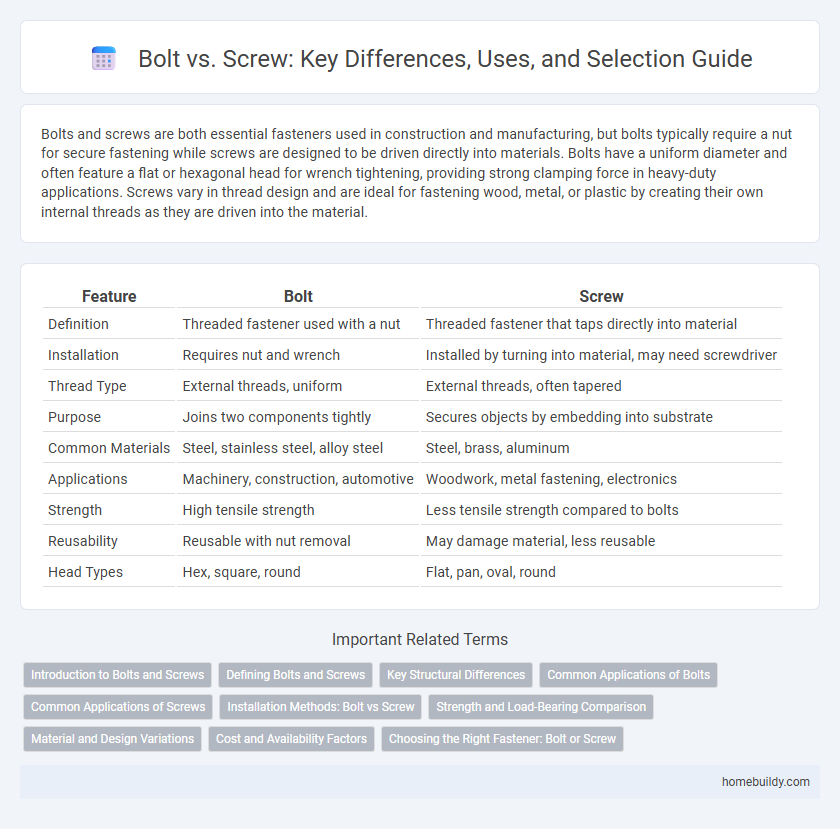Bolts and screws are both essential fasteners used in construction and manufacturing, but bolts typically require a nut for secure fastening while screws are designed to be driven directly into materials. Bolts have a uniform diameter and often feature a flat or hexagonal head for wrench tightening, providing strong clamping force in heavy-duty applications. Screws vary in thread design and are ideal for fastening wood, metal, or plastic by creating their own internal threads as they are driven into the material.
Table of Comparison
| Feature | Bolt | Screw |
|---|---|---|
| Definition | Threaded fastener used with a nut | Threaded fastener that taps directly into material |
| Installation | Requires nut and wrench | Installed by turning into material, may need screwdriver |
| Thread Type | External threads, uniform | External threads, often tapered |
| Purpose | Joins two components tightly | Secures objects by embedding into substrate |
| Common Materials | Steel, stainless steel, alloy steel | Steel, brass, aluminum |
| Applications | Machinery, construction, automotive | Woodwork, metal fastening, electronics |
| Strength | High tensile strength | Less tensile strength compared to bolts |
| Reusability | Reusable with nut removal | May damage material, less reusable |
| Head Types | Hex, square, round | Flat, pan, oval, round |
Introduction to Bolts and Screws
Bolts and screws are essential fasteners designed to join materials securely, with bolts typically requiring a nut for fastening while screws are usually self-threading into materials. Bolts feature a uniform shank and external threading that engage with pre-made holes, providing strong clamping force in mechanical assemblies. Screws have tapered threads and can create their own threads in softer materials like wood or plastic, making them ideal for fastening without additional hardware.
Defining Bolts and Screws
Bolts are external threaded fasteners designed for use with a nut to clamp multiple components together, offering high tensile strength and easy disassembly. Screws are threaded fasteners that typically cut into the material or use pre-drilled holes, providing secure fastening without the need for a nut. Both bolts and screws vary in thread design, head shape, and application, with bolts emphasizing clamping force and screws focusing on direct material engagement.
Key Structural Differences
Bolts typically have a uniform diameter along the shank and require a nut for fastening, creating a strong clamping force suitable for heavy-duty applications. Screws usually have a tapered shaft that cuts threads into the material, enabling direct fastening without a nut, ideal for lighter or precision work. The key structural difference lies in the bolt's external threading matched with a nut versus the screw's self-threading design into materials.
Common Applications of Bolts
Bolts are commonly used in construction, automotive assembly, and heavy machinery due to their high tensile strength and ability to be tightened with nuts for secure fastening. They are ideal for applications requiring disassembly and reassembly, such as engine parts and structural frameworks. Bolt fastening ensures reliable load distribution and resistance to vibration, making them essential for industrial and mechanical projects.
Common Applications of Screws
Screws are commonly used in woodworking, metalworking, and construction due to their ability to provide strong, removable joints with precise clamping force. They are ideal for fastening materials where disassembly or adjustment is required, such as cabinetry, furniture assembly, and machinery maintenance. Self-tapping screws are frequently employed in automotive and electrical applications for securing components without pre-drilling.
Installation Methods: Bolt vs Screw
Bolts require a nut and often a washer for installation, relying on pre-drilled or pre-tapped holes and tools like wrenches to achieve precise torque and secure fastening. Screws are typically installed directly into materials, creating their own threads or engaging existing ones, using tools such as screwdrivers or power drills for rapid and straightforward fastening. The installation method for bolts emphasizes strength and reusability in heavy-duty applications, while screws offer convenience and speed for lighter, less demanding tasks.
Strength and Load-Bearing Comparison
Bolts typically exhibit higher tensile strength than screws due to their thicker cores and uniform thread pitch, making them more suitable for heavy load-bearing applications. Screws, with their tapered shafts and sharper threads, often provide superior holding power in softer materials but are less effective under high shear stress. In structural assemblies, bolts are preferred for their ability to withstand greater load and vibration without loosening, ensuring enhanced joint integrity.
Material and Design Variations
Bolts and screws differ significantly in material selection and design variations to suit their specific applications; bolts commonly use high-strength steel alloys, stainless steel, and sometimes brass or aluminum for corrosion resistance and durability in heavy-duty fastening. Screws feature a wider range of materials including carbon steel, brass, and plastic composites, tailored for precision, versatility, and light-to-medium load demands, with design variations such as thread patterns and head styles optimized for different substrates. Material hardness, thread geometry, and coating technologies define their performance characteristics, with bolts generally emphasizing tensile strength and screws focusing on ease of installation and specialized holding power.
Cost and Availability Factors
Bolts generally cost more than screws due to their larger size and higher material requirements, impacting overall project expenses. Screws are widely available in various sizes and materials, making them more accessible and often more economical for general use. The choice between bolts and screws depends on budget constraints and supply chain accessibility in construction or manufacturing applications.
Choosing the Right Fastener: Bolt or Screw
Selecting the right fastener hinges on application requirements; bolts are ideal for heavy-duty joints requiring high tensile strength and are typically used with nuts and washers for secure fastening. Screws provide efficient fastening in softer materials without the need for nuts, offering easier installation and removal in precision applications. Understanding load conditions, material thickness, and environmental factors ensures optimal performance when choosing between bolts and screws.
Bolt vs Screw Infographic

 homebuildy.com
homebuildy.com